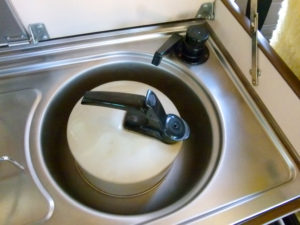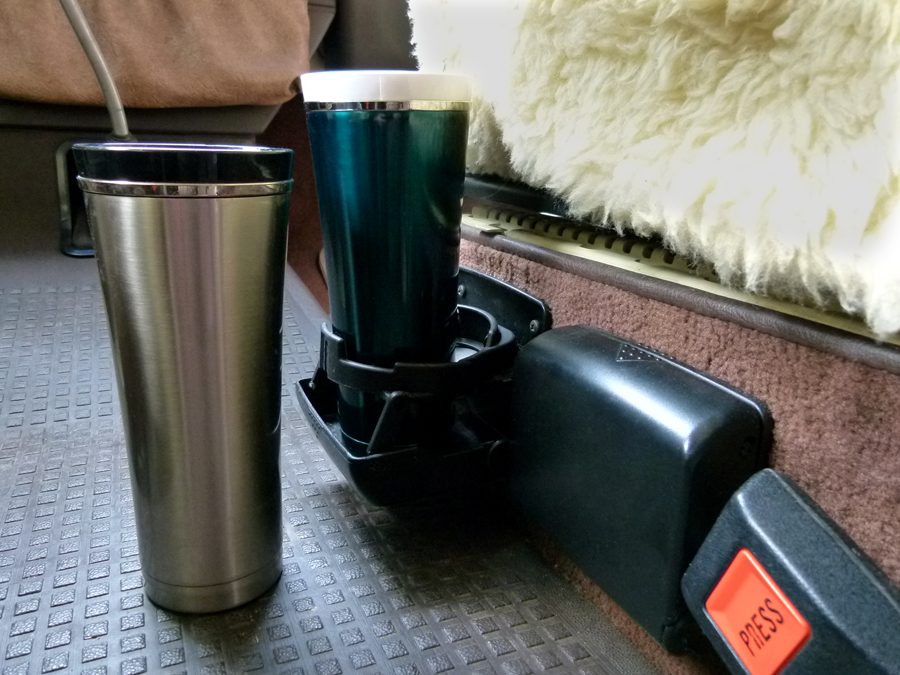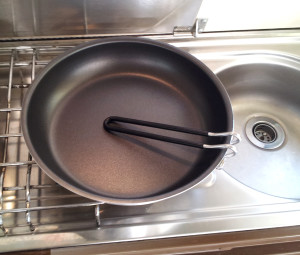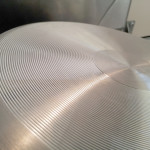How to outfit and organize your campervan kitchen to make the most of your precious cooking and clean-up time!
The Westfalia Camper boasts a small galley kitchenette which includes a refrigerator powered by AC/DC electricity or by liquid propane, a two-burner LP stove for cooking, and a sink for food prep and cleanup. Storage for food and kitchen wares is provided by several cabinets.
 Like most campervans and other small motorhomes, space is at a premium, so smart use of limited resources will help you stay organized and make cooking easy and fun. Here are some ideas for outfitting your own camper van kitchen.
Like most campervans and other small motorhomes, space is at a premium, so smart use of limited resources will help you stay organized and make cooking easy and fun. Here are some ideas for outfitting your own camper van kitchen.
Feel free to grab the graphic or share the article with friends or on your own blog or website!

Storage
Dry packaged and canned goods are perhaps best kept in the two rearmost top-entry cabinets. A compact tea kettle with folding handle may fit inside the sink, along with Camp-Suds and scrubby for dishwashing.
 Cutlery, knives, can opener, and most other cooking utensils will fit in the small drawer below the sink.
Cutlery, knives, can opener, and most other cooking utensils will fit in the small drawer below the sink.
The large cabinet below provides pretty ample storage for pots, pans, griddles, and food storage containers. A dishpan serves as a handy ‘drawer’ to organize most cooking wares, and can also be used for its original purpose.
To prevent jostling and annoying rattles while driving, place thin rubber shelf liners inside cabinets, and dish towels and pot holders or trivets can be laid over the stove burners.
Just as at home, you’ll want to store leftovers or other unused foods for later use. Lightweight plastic food containers with snap-on lids save space, both when nested for storage, and when stacked for keeping food. Work well for dry goods and refrigerated items. Smaller quantities can be kept in zipper-lock plastic baggies. A few chip clips for resealing plastic food and snack bags.
Work Surfaces
Space for food prep is in short supply in the Westfalia, so be smart and creative.
The original Westy table can be mounted either directly behind the driver’s seat, or above the rear kitchen cabinets, and can be pivoted in a range of positions for best use.
If not immediately using the stove burners, flip down the stainless steel drain board, or close the lid completely to use the countertop surface.
 When the popup roof is raised, there is a large ‘shelf’ offered by the folded upper bunk; this is a great place for ingredients, cookware, and utensils you’ll be using immediately.
When the popup roof is raised, there is a large ‘shelf’ offered by the folded upper bunk; this is a great place for ingredients, cookware, and utensils you’ll be using immediately.
A large cutting board makes for an additional, portable work surface for chopping vegetables, assembling sandwiches, and other food prep. Get one with raised edges to help contain messes.
Cooking
Modern cooksets made for camping and backpacking offer several advantages over pots and pans from your home kitchen. Most can be nested inside one another, or feature folding handles, to save space and reduce clutter. They’re often made of aluminum or other lightweight materials. Many feature bottoms optimized for better heat dispersion when cooking on a camp stove or small burner, to avoid scorching.
 Most such cooksets include a small- and a medium-sized pot, a small frypan, and a lid and handle/gripper to fit them all. When cooking for two, a 1 1/2-quart and a 2-quart pot should be sufficient; larger sets are available for larger crews.
Most such cooksets include a small- and a medium-sized pot, a small frypan, and a lid and handle/gripper to fit them all. When cooking for two, a 1 1/2-quart and a 2-quart pot should be sufficient; larger sets are available for larger crews.
Though small, the included frying pan does have its uses for light-duty heating, but you’ll probably want a larger pan for most frying, sautéing, and flapjacking. If your pan doesn’t include a lid, pick one up in a thrift store.
Oven mitts or pot holders protect your hands and countertops when handling hot pans.
A small set of kitchen knives of various sizes with snap-on sheathes will provide all your chopping, dicing, and mincing needs.
Two or three mixing bowls of various sizes; double as serving bowls for chips and other snacks.
Other typical cooking utensils: spatula, spoons, ladles. Smaller, lightweight camping versions save space and weight. Can opener, bottle opener, and corkscrew. Small multi-spice shakers. A grater for cheeses, vegetables, and other foods. A collapsible strainer for draining pasta.
Serving
Cooking in your campervan can be fun, but eating is even better! Again, lightweight and compact is the key here, and dining wares made for camping & backpacking are the ticket.
Stacking, plastic plates and bowls are durable and quiet, and help keep your food warmer longer, especially when dining outdoors.
Matching polycarbonate cutlery offer the same advantages: knives, forks, spoons, even the thrifty and versatile spork.
The same thermal beverage mugs or cups used when driving can be utilized at the dinner table, or use dedicated plastic cups and glasses for meal time.
Use placemats or a heavy vinyl tablecloth on untidy outdoor campsite picnic tables, especially if the previous occupant gutted a couple of brook trout on the table, or was an incontinent seagull …
Clean-up
Seldom the favorite part of mealtime, there’s no need for tidying up to be laborious. Like cooking, let’s keep it quick and easy.
Stow any leftovers away in the storage containers mentioned above. Scrape any heavy remainders from cookware using a thin plastic pot scraper.
A five-gallon plastic bucket with a padded seat, often used by hunters and fisherfolk, also serves as a convenient container for trash and recyclables when lined with a couple of trash bags.
Water can be heated in a teakettle while you eat, then used for dishwashing and cleanup. Simply pour it into the Westfalia kitchen sink or a separate dishpan, and add cold water to temper.
Conserve your biodegradable Camp-Suds by applying a few drops directly to your non-scratch scouring pad. Start by washing your least-dirty cups, cutlery, and plates first, followed by the messier, greasier pots and pans. Rinse cookware directly in the kitchen sink, and set out on the drain board to dry.
Synthetic microfiber dish towels are extra-absorbent and quick-drying.
Dirty dishwater should be collected in a gray-water container, and not drained directly on the ground. Empty the container in a campground toilet or a designated dishwater-collection receptacle.
BONUS
Any ways in which you can get double duty out of your kitchen gear will save you space, expense, and time!
- A large cutting board with raised sides can also be used as a serving platter for sandwiches, wraps, and other foods.
- A flat grater for shredding vegetables and cheese takes up almost no space, and doubles as a pasta strainer!
- Experienced backpackers often eat from the same pot in which they cooked, using the same spoon with which they stirred, to minimize clean-up time.
- Slip dish cloths between pots and plates to protect non-stick coatings, and store towels and pot holders on the stove burners to help reduce annoying rattles while underway.
- Mixing bowls can also be used as serving bowls for snacks, or use food storage containers for both!
Finally …
With some basic camp-cooking and serving wares, and some smart packing, you can make the most of your Westfalia Camper kitchen.
Find more ideas for packing and organizing your entire van here!







































